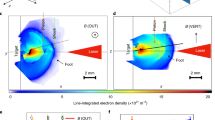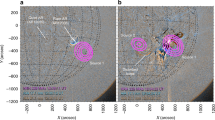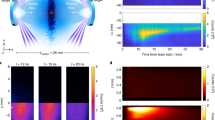Abstract
Cosmic rays and solar energetic particles may be accelerated to relativistic energies by shock waves in astrophysical plasmas. On the Sun, shocks and particle acceleration are often associated with the eruption of magnetized plasmoids, called coronal mass ejections (CMEs). However, the physical relationship between CMEs and shock particle acceleration is not well understood. Here, we use extreme ultraviolet, radio and white-light imaging of a solar eruptive event on 22 September 2011 to show that a CME-induced shock (Alfvén Mach number  ) was coincident with a coronal wave and an intense metric radio burst generated by intermittent acceleration of electrons to kinetic energies of 2–46 keV (0.1–0.4 c). Our observations show that plasmoid-driven quasiperpendicular shocks are capable of producing quasiperiodic acceleration of electrons, an effect consistent with a turbulent or rippled plasma shock surface.
) was coincident with a coronal wave and an intense metric radio burst generated by intermittent acceleration of electrons to kinetic energies of 2–46 keV (0.1–0.4 c). Our observations show that plasmoid-driven quasiperpendicular shocks are capable of producing quasiperiodic acceleration of electrons, an effect consistent with a turbulent or rippled plasma shock surface.
This is a preview of subscription content, access via your institution
Access options
Subscribe to this journal
Receive 12 print issues and online access
$209.00 per year
only $17.42 per issue
Buy this article
- Purchase on Springer Link
- Instant access to full article PDF
Prices may be subject to local taxes which are calculated during checkout




Similar content being viewed by others
References
Byrne, J. P., Maloney, S. A., McAteer, R. T. J., Refojo, J. M. & Gallagher, P. T. Propagation of an Earth-directed coronal mass ejection in three dimensions. Nature Commun. 1, 74 (2010).
Roussev, I. I. et al. Explaining fast ejections of plasma and exotic X-ray emission from the solar corona. Nature Phys. 8, 845–849 (2012).
Vourlidas, A. et al. Comprehensive analysis of coronal mass ejection mass and energy properties over a full solar cycle. Astrophys. J. 722, 1522–1538 (2010).
Klassen, A. et al. Solar energetic electron events and coronal shocks. Astron. Astrophys. 385, 1078–1088 (2002).
Grechnev, V. V. et al. Coronal shock waves, EUV waves, and their relation to CMEs. I. Reconciliation of EIT Waves, Type II radio bursts, and leading edges of CMEs. Sol. Phys. 273, 433–460 (2011).
Vršnak, B. & Cliver, E. W. Origin of coronal shock waves. invited review. Sol. Phys. 253, 215–235 (2008).
Drury, L. O. Origin of cosmic rays. Astropart. Phys. 39, 52–60 (2012).
Wild, J. P. Observations of the spectrum of high-intensity solar radiation at metre wavelengths. III. Isolated bursts. Aust. J. Sci. Res. A 3, 541–557 (1950).
Mann, G. et al. Catalogue of solar type II radio bursts observed from September 1990 to December 1993 and their statistical analysis. Astron. Astrophys. Suppl. 119, 489–498 (1996).
Mann, G. & Klassen, A. Electron beams generated by shock waves in the solar corona. Astron. Astrophys. 441, 319–326 (2005).
Zlobec, P., Messerotti, M., Karlicky, M. & Urbarz, H. Fine structures in time profiles of type II bursts at frequencies above 200 MHz. Sol. Phys. 144, 373–384 (1993).
Guo, F. & Giacalone, J. The effect of large-scale magnetic turbulence on the acceleration of electrons by perpendicular collisionless shocks. Astrophys. J. 715, 406–411 (2010).
Gallagher, P. T. & Long, D. M. Large-scale bright fronts in the solar corona: A review of EIT waves. Space Sci. Rev. 158, 365–396 (2011).
Gopalswamy, N. et al. EUV wave reflection from a coronal hole. Astrophys. J. 691, L123–L127 (2009).
Wang, Y-M. EIT waves and fast-mode propagation in the solar corona. Astrophys. J. 543, L89–L93 (2000).
Long, D. M., Gallagher, P. T., McAteer, R. T. J. & Bloomfield, D. S. Deceleration and dispersion of large-scale coronal bright fronts. Astron. Astrophys. 531, A42–A42 (2011).
Maia, D. J. F. & Pick, M. Revisiting the origin of impulsive electron events: Coronal magnetic restructuring. Astrophys. J. 609, 1082–1097 (2004).
Kozarev, K. A., Korreck, K. E., Lobzin, V. V., Weber, M. A. & Schwadron, N. A. Off-limb solar coronal wavefronts from SDO/AIA extreme-ultraviolet observations—Implications for particle production. Astrophys. J. 733, L25 (2011).
Vršnak, B. et al. Broadband metric-range radio emission associated with a moreton/EIT wave. Astrophys. J. 625, L67–L70 (2005).
Warmuth, A., Vršnak, B., Magdalenić, J., Hanslmeier, A. & Otruba, W. A multiwavelength study of solar flare waves. II. Perturbation characteristics and physical interpretation. Astron. Astrophys. 418, 1117–1129 (2004).
Zhukov, A. N., Rodriguez, L. & de Patoul, J. STEREO/SECCHI observations on 8 December 2007: Evidence against the wave hypothesis of the EIT wave origin. Sol. Phys. 259, 73–85 (2009).
Delannée, C., Török, T., Aulanier, G. & Hochedez, J-F. A new model for propagating parts of EIT waves: A current shell in a CME. Sol. Phys. 247, 123–150 (2008).
Kahler, S. W. Solar sources of heliospheric energetic electron events—Shocks or flares? Space Sci. Rev. 129, 359–390 (2007).
Pesnell, W. D., Thompson, B. J. & Chamberlin, P. C. The solar dynamics observatory (SDO). Sol. Phys. 275, 3–15 (2012).
Lemen, J. R. et al. The Atmospheric Imaging Assembly (AIA) on the Solar Dynamics Observatory (SDO). Sol. Phys. 275, 17–40 (2012).
Kerdraon, A. & Delouis, J-M. in Coronal Physics from Radio and Space Observations Vol. 483 (ed. Trottet, G.) 192–201 (Lecture Notes in Physics, Springer, 1997).
Dulk, G. A. Radio emission from the sun and stars. Annu. Rev. Astron. Astrophys. 23, 169–224 (1985).
Boischot, A. et al. A new high-gain, broadband, steerable array to study Jovian decametric emission. Icarus 43, 399–407 (1980).
Bougeret, J. L. et al. S/WAVES: The radio and plasma wave investigation on the STEREO mission. Space Sci. Rev. 136, 487–528 (2008).
Benz, A. O. et al. A world-wide net of solar radio spectrometers: e-CALLISTO. Earth Moon and Planets 104, 277–285 (2009).
Zucca, P. et al. Observations of low frequency solar radio bursts from the Rosse solar-terrestrial observatory. Sol. Phys. 280, 591–602 (2012).
Burgess, D. Simulations of electron acceleration at collisionless shocks: The effects of surface fluctuations. Astrophys. J. 653, 316–324 (2006).
Stewart, R. T. & Magun, A. Radio evidence for electron acceleration by transverse shock waves in herringbone Type II solar bursts. Proc. Astron. Soc. Aust. 4, 53–55 (1980).
Schmidt, J. M. & Cairns, I. H. Type II radio bursts: 2. Application of the new analytic formalism. J. Geophys. Res. 117, 11104 (2012).
Brueckner, G. E. et al. The large angle spectroscopic coronagraph (LASCO). Sol. Phys. 162, 357–402 (1995).
Vourlidas, A., Lynch, B. J., Howard, R. A. & Li, Y. How many CMEs have flux ropes? Deciphering the signatures of shocks, flux ropes, and prominences in coronagraph observations of CMEs. Sol. Phys. 192 (2012).
Maloney, S. A. & Gallagher, P. T. STEREO direct imaging of a coronal mass ejection-driven shock to 0.5 AU. Astrophys. J. 736, L5 (2011).
Feng, S. W. et al. Radio signatures of coronal-mass-ejection-streamer interaction and source diagnostics of type II radio burst. Astrophys. J. 753, 21 (2012).
Feng, S. W. et al. Diagnostics on the source properties of a type II radio burst with spectral bumps. Astrophys. J. 767, 29 (2013).
Bain, H. M., Krucker, S., Glesener, L. & Lin, R. P. Radio imaging of shock-accelerated electrons associated with an erupting plasmoid on 2010 November 3. Astrophys. J. 750, 44 (2012).
Ball, L. & Melrose, D. B. Shock drift acceleration of electrons. Publ. Astron. Soc. Aust. 18, 361–373 (2001).
Wu, C. S. A fast Fermi process—Energetic electrons accelerated by a nearly perpendicular bow shock. J. Geophys. Res. 89, 8857–8862 (1984).
Holman, G. D. & Pesses, M. E. Solar type II radio emission and the shock drift acceleration of electrons. Astrophys. J. 267, 837–843 (1983).
Guo, F. & Giacalone, J. Particle acceleration at a flare termination shock: Effect of large-scale magnetic turbulence. Astrophys. J. 753, 28–28 (2012).
Vandas, M. & Karlický, M. Electron acceleration in a wavy shock front. Astron. Astrophys. 531, A55 (2011).
Lowe, R. E. & Burgess, D. The properties and causes of rippling in quasi-perpendicular collisionless shock fronts. Ann. Geophys. 21, 671–679 (2003).
Aurass, H. & Mann, G. Radio observation of electron acceleration at solar flare reconnection outflow termination shocks. Astrophys. J. 615, 526–530 (2004).
Van Haarlem, M. P. et al. LOFAR: The low-frequency array. Astron. Astrophys. 556, A2 (2013).
Stewart, R. T. & McLean, D. J. Correcting low-frequency solar radio source positions for ionospheric refraction. Proc. Astron. Soc. Australia 4, 386–389 (1982).
Long, D. M., DeLuca, E. E. & Gallagher, P. T. The wave properties of coronal bright fronts observed using SDO/AIA. Astrophys. J. 741, L21 (2011).
Acknowledgements
We would like to thank NASA’s SDO, STEREO and ESA/NASA’s SOHO teams, and the Nançay Radio Astronomy Observatory for providing open access to their data. Financial support of E.P.C. was provided by the Irish Research Council Embark Initiative. D.M.L. is financially supported by the European Commission’s Seventh Framework Programme under the grant agreement No. 284461 (eHEROES project). J.P.B. is supported by SHINE grant 0962716 and NASA grants NNX08AJ07G and NNX13AG11G to the Institute for Astronomy. P.Z. is financially supported at present under the Trinity College Dublin Innovation Academy Bursary. D.S.B. is financially supported under the ESA PRODEX programme. We would also like to extend thanks to the Birr Scientific and Heritage Foundation, supported by the Earl of Rosse. Special thanks is extended to C. Monstein for his support in setting up the Callisto spectrometers and J. Magdalenić for very useful scientific discussions.
Author information
Authors and Affiliations
Contributions
E.P.C. performed the data analysis of the radio source kinematics, the radio burst analysis, the Alfvén Mach number calculations, and the in situ particle analysis. E.P.C. also wrote the article. D.M.L. performed the data analysis of the coronal bright front and gave constructive advice on the writing of the article. J.P.B. performed the 3D reconstruction of the CME and gave advice on the white-light shock analysis section. P.Z. provided the density maps, and D.S.B. provided the magnetic field maps that were used in the radio source and CBF Mach number calculations. J.M. installed the electronic systems at RSTO. P.T.G. conceived of the project and guided data analysis and writing of the article.
Corresponding author
Ethics declarations
Competing interests
The authors declare no competing financial interests.
Supplementary information
Supplementary Information
Supplementary Information (PDF 801 kb)
Supplementary Movie
Supplementary Movie 1 (MOV 23453 kb)
Supplementary Movie
Supplementary Movie 2 (MP4 16090 kb)
Rights and permissions
About this article
Cite this article
Carley, E., Long, D., Byrne, J. et al. Quasiperiodic acceleration of electrons by a plasmoid-driven shock in the solar atmosphere. Nature Phys 9, 811–816 (2013). https://doi.org/10.1038/nphys2767
Received:
Accepted:
Published:
Issue Date:
DOI: https://doi.org/10.1038/nphys2767
This article is cited by
-
Cylindrical shock wave propagation in a self-gravitating rotational axisymmetric perfect gas under the influence of azimuthal or axial magnetic field and monochromatic radiation with variable density
Pramana (2021)
-
Finding Spots in a CME-Related Shock Where Physical Conditions Can Emerge Favoring Type II Radio Burst Generation on 2010 June 13
Solar Physics (2021)
-
Comprehensive Characterization of Solar Eruptions with Remote and In-Situ Observations, and Modeling: The Major Solar Events on 4 November 2015
Solar Physics (2020)
-
Multiple regions of shock-accelerated particles during a solar coronal mass ejection
Nature Astronomy (2019)
-
Loss-cone instability modulation due to a magnetohydrodynamic sausage mode oscillation in the solar corona
Nature Communications (2019)



